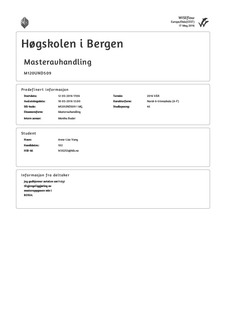| dc.contributor.author | Vang, Anne-Lise | |
| dc.date.accessioned | 2018-02-01T14:34:49Z | |
| dc.date.available | 2018-02-01T14:34:49Z | |
| dc.date.issued | 2016-05-18 | |
| dc.identifier.uri | http://hdl.handle.net/11250/2481343 | |
| dc.description | Master i undervisningsvitenskap med engelsk fagdidaktikk | en_GB |
| dc.description.abstract | The following research project focuses on young Norwegian learners of English as a foreign language, and their realisation of consonant speech sounds that typically create difficulties for Norwegian learners, namely /z, v, w, dʒ, θ, ð/. The research project is a quasi-experimental intervention in two seventh grade classes at a school in Norway. The intervention lasted for three weeks, following both the regular lesson plan and time schedule, however, pronunciation and phonemic symbols were included in order to see if the target sounds provide a problem, and if so, does explicit focus on pronunciation improve the realisation of the target sounds? In addition to the experimental group, a control group consisting of 11 participants from a different school participated. The research followed a pre-test/post-test design. For the pre-test, the participants read a list of 29 words consisting of one, maximum two, of the target sounds into a sound recorder, in addition to answering a questionnaire in order to map the participants’ experience with phonemic symbols. The post-test was identical to the pre-test, however, with this group the questionnaire was left out. Both the experimental group and the control group participated for the tests. The control group did not receive any teaching from the researcher. The sound recordings were transcribed, and scored. An incorrect speech sound was given the score 0, whereas a correct speech sound was given the score 1. In total, more than 2500 tokens were analysed and transcribed. The participants from the control group improved their average realisation of the target sounds with about 2 %, whereas the average score for the experimental group was over 16 %. In order to measure the statistically significance for the results, a Mann-Whitney U test was conducted. The Mann-Whitney U test was used to measure the statistical significance of the findings. Although the test exhibited a statistically significant result for the speech sounds combined, it did not provide a statistically significant result for the speech sounds measured individually, and thus, the results from the significance test should be interpreted with caution. Nonetheless, the improvement of the realisation of the six speech sounds in the experimental group was 14 % higher than that of the control group. | en_GB |
| dc.description.abstract | Dette forskningsprosjektet fokuserer på norske elevers uttale av de engelske konsonantlydene /z, v, w, dʒ, θ, ð/. Ettersom disse lydene ikke eksisterer i muntlig norsk byr de ofte på problemer for elever som skal lære seg engelsk. Forskningen er basert på en kvasieksperimentell intervensjon hos to syvendeklasser på en skole i Norge. Intervensjonen varte i tre uker, og den fulgte elevenes fastsatte timeplan og undervisningsplan, men uttale og enkelte fonemer ble introdusert for elevene, både for å fastslå om de aktuelle språklydene er et problem for elevene, og om så er tilfelle, om et eksplisitt fokus på uttale og fonemer kan bedre elevenes uttale av disse språklydene. I tillegg til testgruppen deltok også en kontrollgruppe bestående av elleve elever fra en annen skole. Forskningen fulgte et pretest/posttest design. Elevene leste en liste med 29 ord, hvor hvert ord inneholdt minst én, maksimum to, av de aktuelle språklydene. Det ble gjort opptak av dette ved hjelp av en digital diktafon. I tillegg fikk elevene utdelt et spørreskjema i et forsøk på å kartlegge deres kjennskap til fonemer, og i hvilken grad de snakket engelsk på skolen. Posttesten var identisk til pretesten, med unntak av at spørreskjemaet ble utelatt. Både testgruppen og kontrollgruppen deltok på begge testene. Kontrollgruppen ble ikke undervist i fonetikk eller uttale. Lydopptakene ble transkribert og tildelt poeng, der feil språklyd gav null poeng, riktig språklyd tilsvarte ett poeng. Totalt ble mer enn 2500 ord analysert og transkribert. Deltakerne fra kontrollgruppen forbedret den gjennomsnittlige uttalen av problemlydene med rundt 2 %, mens testgruppen forbedret sin uttale av de aktuelle lydene med et gjennomsnitt på over 16 %. En Mann-Whitney U test ble tatt i bruk for å måle om resultatene var statistisk signifikante. Til tross for at testen viste til et statistisk signifikant resultat bør dette leses med varsomhet, ettersom ingen av enkeltlydene tilsvarte signifikans. Likevel kan man slå fast at testgruppen forbedret uttalen sin betydelig sammenlignet med kontrollgruppen. | en_GB |
| dc.language.iso | eng | en_GB |
| dc.publisher | Bergen University College | en_GB |
| dc.rights | Attribution 3.0 Norway | * |
| dc.rights.uri | http://creativecommons.org/licenses/by/3.0/no/ | * |
| dc.title | Teaching Oral English in the Norwegian EFL Classroom -With an explicit focus on the realisation of / z, v, w, dʒ, θ, ð / | en_GB |
| dc.title.alternative | Muntlig engelskundervisning i norske klasserom - Med et eksplisitt fokus på uttalen av / z, v, w, dʒ, θ, ð / | en_GB |
| dc.type | Master thesis | en_GB |
| dc.subject.nsi | VDP::Samfunnsvitenskap: 200::Pedagogiske fag: 280 | en_GB |

